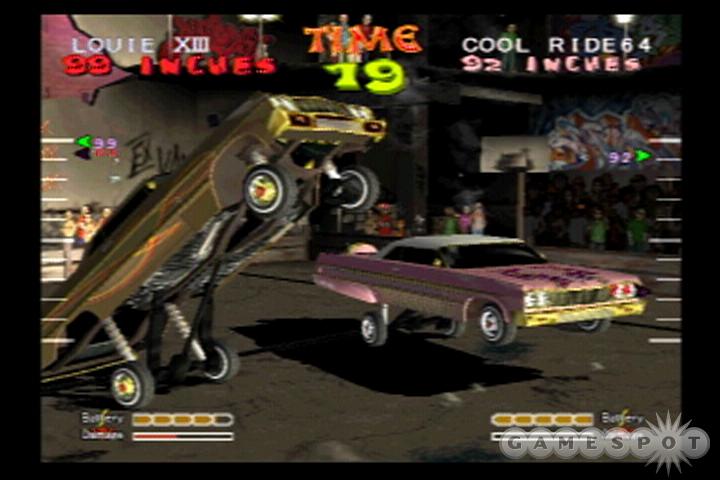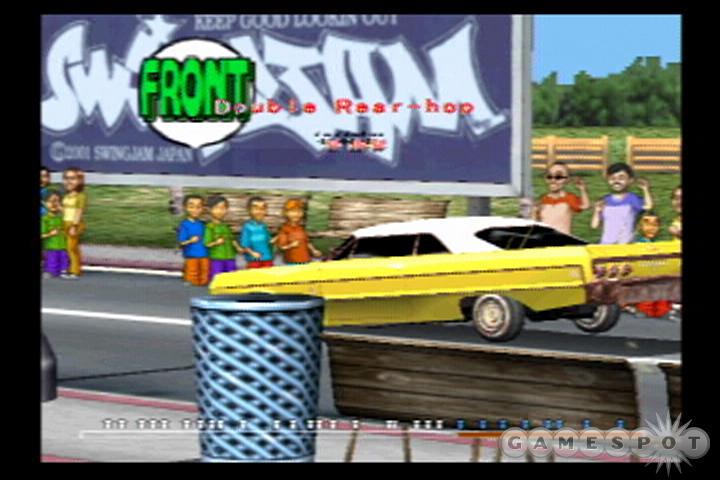There's really nothing else out there quite like Jaleco's peculiar rhythm game Lowrider. It's probably the only game focused entirely on cars where you never actually get to drive the car. The subject matter of in-depth car customization has been tackled by other games, most recently EA's Need for Speed Underground, but no other game before Lowrider has addressed it in quite the same way--and, honestly, the game's flavor is so peculiar, it's more than likely that no other game ever will. There's not a lot to Lowrider, and it only really works if you have an appreciation for its take on lowriding and its generally oddball sensibility.

The story mode, which sees you as a nameless kid from the 'hood working his way through the West Coast lowriding circuit, is broken up into a series of different regional competitions and a customization mode. There's the hop contest, where you and another lowrider have a minute to get your front bumper as high off the ground as possible by using your hydraulics. In the dance contests, you and another lowrider will be given a series of different tricks to pull off, and you'll be scored based on your performance of each. There's also a street mode, where you'll cruise down a strip while pedestrians shout out moves they want to see. If you pull off the moves successfully, the pedestrians will become fans, and fans can net you bonus points in the event competitions later on. The dance contests start off simple enough, with basic moves like the front hop and the rear hop requiring a single button press, but as you advance, the dancing gets more complex, like the octopus move, which requires you to smoothly hop from one wheel to another in a circular motion. Once you've completed the dance, hop, and street contests in a region, you'll be able to compete in the main event, which is series of three consecutive dance contests that you'll need to win in order to advance to the next city.
The car you start off with in Lowrider's story mode is pretty beat-up, with a rusted-out paint job and just barely the minimum hydraulic power you need to hop, so once you start getting money from winning contests, you'll want to go into the game's customization mode and trick out your car. Though the components that you have to choose from aren't extensive, you can customize 18 different parts of your car, ranging from the hydraulics to large, ornate murals on the hood of your car--you can even design your own murals, which allows you to add a bit of a personal touch to your ride. Outside of Lowrider's story mode, there's an arcade-style mode where up to two players can take some prefab lowriders and compete in hop, dance, and bed dance contests, the third of which is restricted to trucks that use powerful hydraulic arms to lift the bed of the truck up into the air and swing it around. Though it's centered on the art of making cars "dance" with the use of hydraulic suspension systems and significant customization rather than music or actual dancing, Lowrider is essentially a rhythm game. It's interesting to see a rhythm-based mechanic applied to something outside your usual music/dancing game, and there's definitely something sort of novel about the gameplay at first, but there's not a whole lot of variation or depth here, and the gameplay gets stale after a while.
Lowrider doesn't offer much technically in terms of presentation, but it does have a very unique aesthetic, presenting the Southern California Latino-influenced classic car culture from the perspective of a Japanese game developer--there are little glimpses of Enix's Bust A Groove games in Lowrider, though there's definitely a lot more Old English typeface in Lowrider. Since the cars are really the stars of the show, Lowrider puts most of its energy into making them look good, and for the most part, it succeeds. But the rest of the game suffers for it--the environments are simple and coated in low-resolution textures that are blurry, and they exhibit some pretty bad color banding, some shoddy particle effects, and sprite-based pedestrians with only a few frames of animation and a visible bounding box. To give you some perspective, Lowrider's visuals could have been done on the Dreamcast without breaking much of a sweat.
In bringing Lowrider to the US, Jaleco has made only a few superficial alterations to the game, replacing the charmingly bad CG "leg shows" with charmingly bad FMV clips of girls riding around in tricked-out cars, changing a few names, and adding "Get Low" by Lil Jon & the East Side Boyz to the soundtrack. The rest of the soundtrack consists of what sounds like Japanese hip-hop DJs trying to replicate the West Coast hip-hop sound, and the voice acting follows suit, sounding like Japanese guys trying their best to do an American guy voice. Though none of it is executed terribly well, the most disappointing part of the audio in Lowrider is the sounds that accompany the hopping, since the mechanical clanging drowns out any sort of hydraulic noises, and they never change regardless of what hydraulic components or vehicle you're using.

Lowrider is a shining example of quirky Japanese game design. The fact that the game provides a Japanese take on lowriding culture, which has a small but passionate following in Japan, makes it even stranger. If cultural cross-pollination of this type intrigues you, or if you just like lowriding, the game is worth at least a look. Despite its lack of polish or depth in just about every facet of its execution, Lowrider has a lot of heart and is notable for at least trying something new.